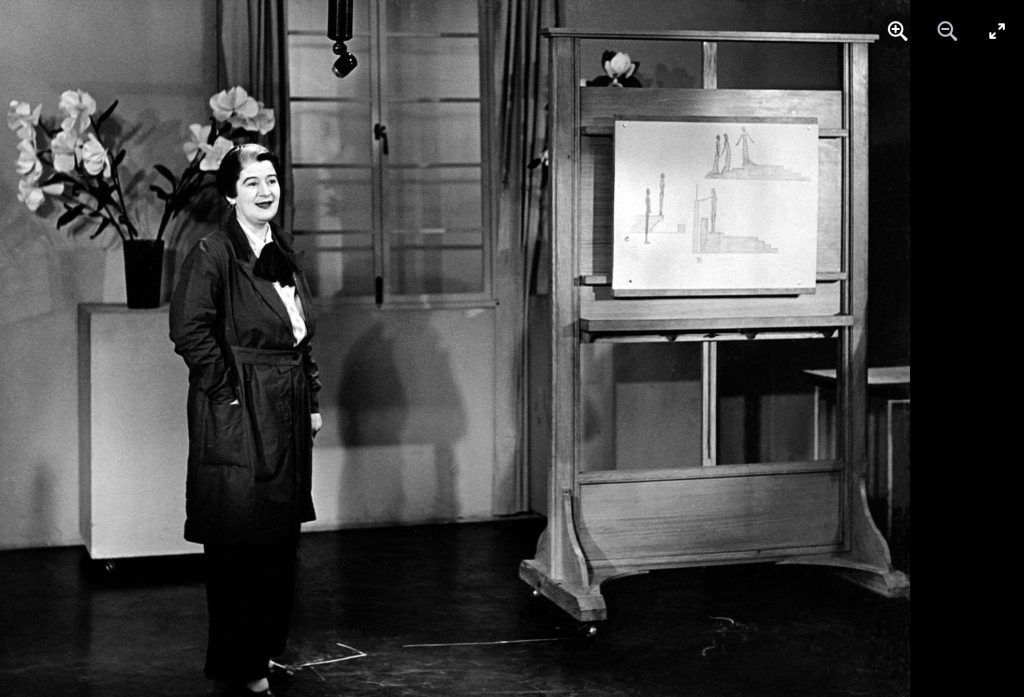OTD in early British television: 12 January 1937

John Wyver writes: Tuesday 12 January 1937 saw the first broadcast from Alexandra Palace of a series titled The World of Women. Conceived by producer Cecil Lewis, who was soon to depart for Hollywood, the fortnightly strand of broadcasts on the social and artistic activities of women’ would be inherited and enhanced by his successor, Mary Adams. As can be seen in this rather wonderful BBC archive image, this first programme featured designer Molly McArthur speaking about her sets and costumes for the Tyrone Guthrie’s Old Vic production of Love’s Labour’s Lost.
This first World of Women talk was broadcast from AP’s studio B via the clunky and inefficient Baird system, which by mid-January was in its penultimate week of operation. The microphone is one indication of that (as Simon Vaughan spotted when the image was first released by BBC Archive), but even more obvious is the make-up of a whitened face and heavy eyebrows and lips imposed on Molly McArthur. This was necessary for the lower image resolution of the 240-line Baird system when compared to the 405-line Marconi-EMI cameras. The strong contrasts in her suit and seemingly in her hair also would have contributed to a more recognisable picture.
The image is also noteworthy among pre-war publicity images in not featuring a television camera, but that too can be explained by it coming from Studio B where it was almost impossible to photograph a subject together with any recognisable part the Baird system. After the switchover to working solely with the Marconi-EMI system, Emitron cameras were ubiquitous in images of this kind.
After a career as an illustrator of children’s books, Molly McArthur started as a theatre designer in the early 1920s and contributed extensively to Old Vic and Stratford Memorial Theatre productions between the wars. In early 1937 she was working on the New Theatre production of As You Like It with Marie Ney and Michael Redgrave, to which she contributed settings and costumes inspired by the Rococo painter Watteau.
As her biography on IMDb notes:
After the war she renewed her association with Esmé Church and together they founded the Northern Children’s Theatre, which gave practical training to young actors in the north of England as well as entertainment for children. Robert Stephens and Edward Petherbridge are just two of the actors whose careers started there.
As for the broader context, radio had been presenting afternoon programmes specifically for women for more than a decade, and television quickly introduced what one journalist called broadcasts with ‘a direct feminine appeal’. As the article in the December 1936 Practical and Amateur Wireless recorded:
Items are being included, especially in the afternoon, which are designed to captivate the taste of women. It is natural that at all the large stores the women outnumber the men in the audience at this time of the day. Many domestic subjects are being illustrated.
The first such transmission was Women’s Interests: A Laundry Demonstration, with ironing tips from Mrs Daisy Pain, and this was followed by Quarter-of-an-Hour Meals with low-budget cookery expert Moira Meighn. Indicative of the class composition of the audience, however, was the viewers’ report note that such demonstrations ‘were condemned as of little interest to those who could afford television sets.’
More appropriate, arguably, for the middle-class female viewers were fashion shows, including presentations of beach wear and current fashions in furs. These were organised by Harold Plaister and G. R. Kenward-Eggar, who had previously collaborated on runway shows for the 30-line transmissions.
The World of Women continued the attempt to appeal to a more upscale female audience. A second programme featured documentary filmmaker Mary Field, speaking about her Secrets of Nature series, and future guests included painter Laura Knight, sculptors Lady Kennet and Dora Clarke, and architect Elizabeth Denby. ‘Houses or homes?’ was the title of Denby’s contribution, which ‘was illustrated by models of slums and a block of up-to-date working-class flats, with clubs and a nursery school included as part of the estate.’
In March, the sixth edition featured poet Olga Katzin composing and reading verse, ‘making a forecast of life a hundred years hence’, while Pearl Binder, who was a frequent collaborator with Mary Adams, illustrated elements with blackboard drawings.
As Sarah Arnold wrote in her 2021 book Gender and Early Television: Mapping Women’s Roles in Emerging US and British Media, 1850-1950:
Although the title of the series immediately gendered the content, it can also be understood as positioning women as key figures in the various fields featured on the programme… [The series] could be considered as evidence of the BBC’s role in generating a sense of normalcy about women in the professional and cultural spheres.’
Continues to be fascinating, with so many links to other branches of interwar British culture. What John’s assiduous research is demonstrating a new aspect of the condescension toward intermediate technology (eg the Kinetoscope). Because BBC TV in the 30s was shortlived and ‘primitive its content hasn’t been taken seriously. But these OTDs are proving otherwise.